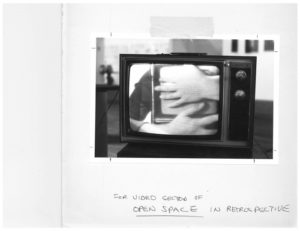Imagine the awe of the viewers in front of their box-like televisions in 1969 when they watched the first black-and-white images—sent by a slow-scan television (SSTV)—of the moon. This then-cutting-edge technology allowed transmission of images through voice frequencies across two stations—in the above case, between the moon and the Earth.
“Slow-scan was built around this dialogue between one station to another. It was the first way that images were able to be sent across far geographic distances,” says Open Space artist-in-residence Kerri Flannigan, who is one of the four artists involved in the collaborative exhibit Distance Between Us.

In 1978, the artist-run Open Space gallery used SSTV as part of a curatorial program. Revisiting SSTV and the archives of Open Space since June 2017, Flannigan is exploring what this technology means today. Collaboration with artists and the community and experiments with slow-scan video were displayed in her exhibit Feeling Measurements, which is now slowly metamorphosing into Distance Between Us.
“[It’s] a conversation between archival history in Open Space around this technology of slow-scan and contemporary responses to what slow-scan as a medium has to offer,” says Flannigan.
Flannigan’s residency allowed her to have access to a slow-scan machine and collaborate with artist Patrick Lichty on making videos with it. The residency has included several community workshops where participants had conversations on how to relate to physical, emotional, technological, and sonic environments.
“[We were] taking this idea of the fathom as this way of measurement based on the body and creating this index of knots, but taking that and doing our own thing with it, so we had a lot of conversations with story prompts,” Flannigan says.
Participants made zines using the risograph machine—a kind of photocopier—and also made sound maps after a bird walk in the city. They shared their stories at different spots in Victoria, marking each with a knot on the ropes they carried.
“We would sometimes be knotting during workshops and then have the remnants of those knots displayed in drawings and scattered throughout the [exhibition] space,” says Flannigan.
Flannigan’s residency includes DIY skill sharing and collaborative production with community involvement.
“About half of my practice of making art is in collaboration with other people and community-based work,” she says. “This one, I think, inspired by the dialogue of the slow-scan between two stations, is probably the most collaborative and the most community-involvement-based art project I have been involved in, and that’s been really interesting and inspiring, and I feel like it has given me a lot to think about. It’s kind of new and experimental, a lot of things that came out through the residency.”
Flannigan has worked with microfiche and overhead projectors before, but she doesn’t necessarily want to romanticize old technology or have it take over the art practice. Revisiting old technology in art prompts many questions about its purpose, and about perceptions of time and space.
“Slow-scan was originally about spanning geographic distance and that was new and revelatory and that was cutting-edge technology at the time,” she says. “Now it’s about a real slowing down of exchange, and this sort of degrading of an image of exchange. And what does that have to offer us and wouldn’t that be interesting to explore emotional distances and proximities and use it to explore those kinds of questions, versus the geographic?”
Distance Between Us
Until Saturday, March 17
Open Space
openspace.ca
